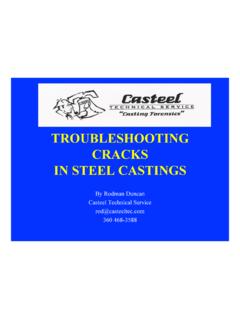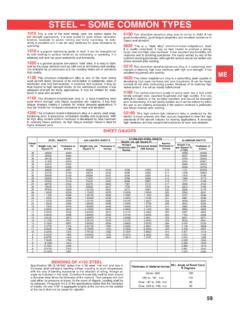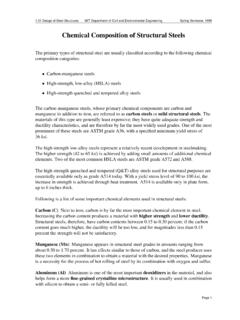Transcription of STEEL CASTINGS HANDBOOK Supplement 8 High Alloy ... - …
1 STEEL CASTINGSHANDBOOKS upplement 8 High Alloy Data SheetsCorrosion SeriesSteel Founders' Society of America 2004 Chemical composition - %C MnSi P S Cr Ni max. bal Physical propertiesModulus of elasticity, psi x , Heat, , at 70 resistivity, , at 70 point, approximate oF2750 Magnetic permeabilityFerromagneticThermal conductivityMean coefficient of Btu/( oF)Linear thermal expansion: (in. oF)_____At 212 - 212 1000 - 1000 properties at room temperatureRepresentativeMinimum tensiletensile properties& toughnessair cooled fromrequirements>1900 oFASTM A743,temper at 1100-A7571150 oF_____Tensile strength, ksi strength, offset, , in 2in.
2 , %2415 Reduction of area, %6035 Brinell hardness (HBW)268-Charpy V-notch, @ -100 oF, (A757)AToughness and impact propertiesImpact, Charpy V-notch - see toughness, Kic - see elevated temperaturesShort time elevated temperature properties - see rupture properties - see Table 1 and Figs. 4 - 6_____A 20 average on three specimens, 15 minimum allowed on onespecimen onlyCorrosion Resistant Type CA6NM (UNS J91540)DescriptionType CA6NM is an iron-chromium-nickel-molybdenum Alloy that ishardenable by heat treatment.
3 It issimilar in general corrosion resistance totype CA15, but the addition of nickel andmolybdenum to the CA6NM compositionimproves its resistance to attack by seawater. Although the tensile strengthproperties of CA6NM are comparable tothose of CA15, the impact strength isabout twice as high, as is the resistanceto damage from cavitation sections and complex structuresare cast in CA6NM with less difficultythan experienced with the CA15 Alloy ,and for cast-weld construction, or wherefield welding is involved, type CA6 NMoffers the advantage of not requiring apreheat.
4 A major application of the alloyhas been in large hydraulic turbinerunners for power Alloy normally is used in thenormalized and tempered condition inwhich the microstructure is essentially100 percent martensite. CA6NM cancontain appreciable amounts of retainedaustenite because this structure providesthe optimum combination of strength,ductility, hardness, and in heat treatment can beselected to enhance one or more ofthese properties. Improved corrosionresistance, particularly resistance tosulfide stress corrosion, can be obtainedwith a lower carbon as in grade CA6 NMClass B (ASTM A487).
5 A lower carboncontent, as in grade CA6NM Class B,permits heat treating to a lowermaximum hardness (and strength) whichresults in improved corrosion resistance,particularly resistance to sulfide stresscorrosion of type CA6NM Alloy have goodmachining and welding properties ifproper techniques are employed. Thealloy is magnetic and has a coefficient ofthermal expansion slightly less than thatof carbon STEEL . Thermal conductivity isabout 45 percent less than carbon STEEL but almost 60 percent greater than the CF Alloy types.
6 Electricalresistivity is about five times that of carbon TreatmentThe Alloy is hardened by heating between 1900 and 1950 F (1038 to 1066 C) followed by cooling in eitherair or oil. After the CASTINGS have cooled below the martensite finish temperature, which varies with thecompositional balance, they should be tempered as soon as possible. Depending on strength requirements,the Alloy is tempered at 600 F (316 C) or more commonly in the range of 1100 to 1150 F (593 to 621 C).Tempering in the vicinity of 900 F (482 C) should be avoided because lower toughness will result.
7 Some re-austenitization may occur if tempering temperatures above 1200 F (649 C) are employed, and upon cooling,the microstructure may contain untempered martensite. Double tempers are employed to achieve hardnessvalues below 22 HRC for CASTINGS intended for wet H2S environments. A typical double temper heat treatmentwould consist of a 1250 F (677 C) temper followed by a 1125 F (607 C) strength and hardness are obtained by tempering at 600 F (316 C); however, impact strength isreduced by 50 percent and ductility is reduced to about 12 percent.
8 Holding times for austenitizing andtempering will vary with the thickness of casting sections involved, but should be sufficiently long to heat allsections to a uniform temperature following lists of consuming industries, cast parts, and corrosive materials are useful as examples oftypical applications where type CA6NM Alloy has been employed successfully; they are not comprehensive,nor are they intended as guides to Alloy selection for specific end Chemical, Marine, Oilfield, Petroleum Refining, Pollution Control, Power Casings, compressor impellers, diaphragms, diffusers, discharge spacers, Francis runners,hydraulic turbine parts, impulse wheels, packing housings, propellers, pump impellers, suction spacers, valvebodies and Boiler feed water [250 F (115 C)], sea water, steam, sulfur, water to 400 F (204 C).
9 NOTE: Corrosion rate data obtained in carefully controlled laboratory tests using chemically pure reagentsare helpful in screening alloys for further consideration, but the difference between such tests and commercialoperation should not be overlooked. Concentration, temperature, pressure, contamination, and velocity ofcorrosives all influence the rate of attack, as do surface finish and casting design. Reference should be madeto the extensive alphabetical lists of corrodents published by many Alloy foundries and to corrosion datasurveys published by the NACE to determine whether type CA6NM is suitable for the particular corrosiveinvolved, and the designer should provide the foundry with as much pertinent information as possible onoperating conditions before reaching a definite decision to use this mechanical and physical property data presented in tabular and graphical form are representative for alloyCA6NM.
10 These data are neither average nor minimum values, and should not be used for either specificationor design purposes. Specification and/or design information may be obtained from appropriate technicalassociations such as ASTM, ASME, API, NACE, and ConsiderationsSection thicknesses from 3/16 inch up can be cast satisfactorily in CA6NM Alloy . Somewhat lighter sectionsare feasible depending on casting design and pattern equipment. Complex designs involving light and heavysections are successfully made in this Alloy , but drastic changes in section should be avoided as far aspossible.













